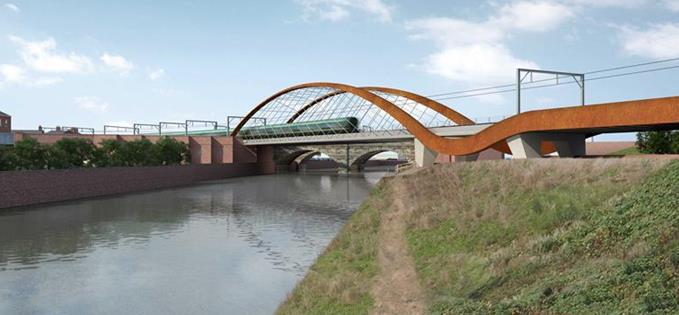THE Ordsall Chord scheme to link Manchester Piccadilly, Oxford Road and Victoria Stations has been approved after an appeal has failed. There has been opposition on the grounds of noise, environmental impact and the compulsory purchase and demolition of properties. But the most compelling case for changing the 'chord' plans has come from heritage campaigners.
It is unique not only in the scale of the harm it will cause to individual heritage assets and their settings, but in the importance of the Liverpool Road station complex which it will damage to a wholly exceptional degree.
The defeat by Network Rail of these groups means the oldest passenger rail system in the world has been castrated. Potential heritage benefits for the region have been lost as the new line will break the link from the 1830 Liverpool Road Station (now part of the Museum of Science and Industry) to the wider railway network. (We explored the unexplored tourist potential of the station here.)
Secretary of State for Transport, Patrick McLoughlin made the reasons clear in his decision letter in these paragraphs:
'The Secretary of State agrees with the Inspector’s assessment of the importance of the buildings and structures affected by the scheme, many of which date from the earliest days of passenger rail travel,and the extent to which the scheme would cause harm to those heritage assets. He agrees, in particular, that substantial harm would be caused bythe demolition of the Grade II listed Girder Bridge and Cast Iron Bridge; that construction of the new chord structure would not preservethe setting of three Grade I listed buildings (the former Liverpool Road Station, the former railway goods warehouse and Stephenson’s Bridge across the Irwell, all of 1830) or of the Grade II listed 1830 and Zig Zag Viaducts; that construction of the chord would be substantially harmful to the significance of those listed buildingsand structures; and that implementation of the scheme would be substantially harmful to the character and appearance of this part of the Castlefield conservation area.
'The scheme as proposed by Network Rail may well provide the only viable option. (The Secretary of State) agrees further that because of the scale of the benefits that would be realised across Greater Manchester and the North of England by the scheme, the harm to heritage assets in the vicinity would in this instance be outweighed by those public benefit.'

Figures of 30,000 new jobs and £4.6bn of wider economic benefits are hard to argue with even if they only prove 25% accurate. But the scheme which will cost £600m and pivot on a £132m viaduct, will smash through the 1830 Liverpool and Manchester Railway (LMR) lines and put the Grade 1 listed George Stephenson designed viaduct which crossed the river here into the literal shade (click here for an article on the significance of this structure).
Everybody agrees on the benefits the ‘chord’ will bring. But as many people have argued, of course the 'chord' should go ahead but shift the alignment a short distance west and a cultural asset of huge international significance will be made safe.
The Ex-Director of the National Science Museum, Sir Neil Cossons, described as ‘Britain’s leading authority on industrial heritage’ has compared Britain’s assets such as the buildings and viaducts associated with LMR as standing ‘with those of Egypt, Athens and Rome as monuments to one of the most fundamental of changes in human history and form a foundation of the world in which we live. Manchester – as the world’s first industrial city – and the first passenger carrying railway were crucial elements in that phenomenon.’
Andrew Davison acting for English Heritage has been even more bullish.
“I have never come across a proposed development so exceptionally damaging to the historic environment as the Ordsall Chord,’ he said in his reply to Network Rail’s proposals during the inquiry.
“It is unique in my experience," he continued, "not only in the scale of the harm which it will cause to individual heritage assets and their settings, but in the importance of the Liverpool Road station complex which it will damage to a wholly exceptional degree."
Calling it the 'Stonehenge of railway history', Davison summed up with, "this is not just a place that has potential to hold more than national significance in relation to railway history this is the place where the modern world began."
Big words.

I conduct tours of Manchester. At the Roman fort in Castlefield I point out the three railway systems that largely obliterated the site.
“The Victorians were funny,” I say. “They almost completely destroyed the fort but to show where it was they put funny little castle shapes on the piers of the viaducts. Odd mentality isn’t it, to mark what you’d deliberately wrecked?”
People smile at the whimsy of those old dead men in top hats with their antiquated opinions about key cultural heritage.
“Of course today we have a different attitude,” I say.
In Castlefield history is repeating itself - bizarrely with the agreement of the Museum of Science and Industry after they initially protested the scheme and then came to a deal with Network Rail for thirty pieces of silver. The Museum has announced plans to retain a steam train experience despite the lost link to the wider network. They’re going to have to very be imaginative with their use of space on their site if the journey is to last longer than Steven Gerrard’s 38 second cameo in the Liverpool and Manchester United match on a recent Sunday.
Sally MacDonald, the Director of the Museum of Science and Industry, who wasn't present at the time of the agreement, has said: The construction of the Chord is a reflection of the same kind of world-changing idea that first brought the railway to Manchester”
She had to say this.
The need for an Ordsall Chord has been proved, its worth will be incalculable.
It's just a crying shame the proposed route could not have been shifted, a crying shame that a brutal attack on this globally significant heritage couldn't have been avoided.
 The Grade One listed 1830 viaduct
The Grade One listed 1830 viaduct














